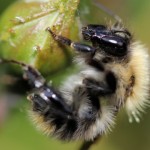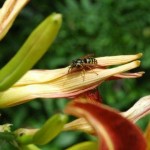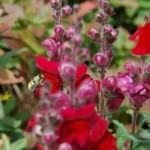Margaret Abbott winces as the venomous lance punctures her flesh. The spear, the stinger of a bee, pumps poison into her foot long after its agitated owner is plucked away and drowned. The tiny venom sac turns black when empty, signaling that the stinger can be scraped off. A red angry circular weal marks the venom’s success. Only 24 stings to go.
While most people avoid being stung by bees, Abbott sits and watches her husband George tweeze another honeybee from their makeshift wooden beehive. He pins the squirming beast down against the same foot.
Not that she could run, even if she wanted to. Abbott, 60, has multiple sclerosis, a disease that has slowly over 23 years stolen her ability to stand or walk without support, her ability to bathe herself, or to perform minor household tasks. And for the past year and a half, she endures 25 bee stings three times a week, trying to slow the disease’s onslaught.
Debbie Haughton shares the same disease. In 1997, only eight years after her diagnosis, Haughton had lost all feeling in her legs, suffered depression, and endured continual falls, frequently injuring herself. When her doctor could offer her no relief, she chose bee venom therapy (BVT).
Apitherapy, the use of natural bee products for therapeutic purposes, is gaining popularity as a viable alternative to the Western medical approach for a variety of degenerative diseases. Multiple sclerosis fits.
Multiple sclerosis is an autoimmune disease where the body’s own immune system declares war on its central nervous system, and actually attempts to destroy the myelin sheath covering the body’s nerve cells. This destruction interrupts and distorts the natural flow of nerve impulses and can cause multiple symptoms including numbness, loss of balance, extreme fatigue, tremors, slurred speech, bladder incontinence, memory loss, depression, blurred vision or blindness, even paralysis. Nerve damage leaves scars or sclera and is usually irreversible. MS sufferers experience an average of three to six exacerbations each year, each lasting weeks.
Canada has one of the highest rates of MS in the world with an estimated 50,000 sufferers. Diagnosis usually occurs between the ages of 20 to 40 and women are twice as likely to develop the disease than men are.
MS has no known cause and no cure. Treatments include steroid therapy attempting to reduce inflammation and nerve damage. But long term use is unsafe. New drug treatments by injection are now available that reduce the number of attacks each year by an average of 33%. Unfortunately many MS sufferers don’t meet the neurological criteria to qualify for the treatments and for those who do, the disease doesn’t always respond.
Both Haughton and Abbott have progressive MS, meaning their bodies are now in a continuous exacerbation. Their prognosis is poor.
Unwilling to give in to the debilitating symptoms of their condition, thousands of people with MS, searching for relief and healing, are turning to alternative therapies and treatments. Even treatments that intentionally entice bees to sting.
“Let’s face it,” Haughton, 43, says, the frustration evident in her voice, “no one knows anything about this disease.” A walker stands next to her, waiting to help her move around her kitchen.
Haughton considered bee venom therapy when she heard several success stories through the media and wanted to try something that seemed credible. Besides, “there were no answers anywhere else,” she says. Her doctor, being the first to admit there’s little he can do, supported her decision.
At first, Haughton’s legs were so numb she couldn’t feel the bees’ sting. She watched them tear into her flesh, and felt nothing. Celebration came a few treatments later when she felt searing pain.
“Feeling pain became a joyful experience for me,” says the mother of five.
Abbott tried BVT when her daughter’s colleague revealed he was a beekeeper and that he stung people with MS.
“I was at the point where I couldn’t see myself even getting out of bed,” Abbott says. “I just didn’t have enough energy.”
Abbott’s husband is efficient in stinging. An ice pack sits on Abbott’s foot in anticipation. He fetches the beehive from the fridge where the swarm of 150 is put to calm down. He slips long tweezers under the lid into the black moving mass, pulling out an angry yellow jacket. George Abbott’s thumb holds the beast in position based on acupuncture points on Abbott’s foot. The frantic honeybee instinctively attacks.
“He’s got me,” Abbott yelps. Her husband is quick with the tweezers again, tossing the wounded bee into a cup of water. Within seconds another bee is twisting between the tweezers and the scene repeats itself. 25 to 30 bee stings take about half an hour including stinger removal.
The benefits? Abbott has enough energy to get out of bed each morning, with a little energy left over for family and friends.
Just six months after starting, Debbie Haughton quit using BVT in March 1998. Bill Mullins, her live-in caregiver discontinued the sessions because he had seen two other MS patients grow dramatically worse while using bee venom.
“If there’s anything to it, the price to be paid to derive any benefit from it is too high,” Mullins explains. “There is no quality control, each bee is unique, and we don’t know how long to keep the stingers in the skin.”
Haughton is not convinced. “I was able to deal with depression, and I felt a little more hopeful (while taking BVT),” she says. She also stopped falling. Since ending the bee sessions she has become more melancholy, needing anti-depressants and although she retains some feeling in her legs, she is falling again.
Mullins believes Haughton’s improvement is due in part to a placebo effect. He thinks his belief in BVT and his support helped her believe in herself.
While Abbott and Haughtons’ success is not dramatic, Pat Wagner has claimed remarkable success from BVT. She was once so disabled from MS she couldn’t wiggle a toe. She travels around the world today needing no mobility aids, and is an international speaker on apitherapy. She has said, “Thanks to Bee Venom Therapy, I’m no longer a breathing corpse due to MS.”
In June 1998, the MS Society of Canada announced the results of a controlled study using BVT headed by Fred D. Lublin, M.D. at Allegheny University in Philadelphia. The findings showed no beneficial effects on mice with EAE, an MS-like disease, with some mice growing worse. Dr. Lublin continues to investigate the individual components of bee venom, hoping that perhaps one ingredient will yield beneficial results.
A study involving BVT and 8 MS patients is underway at Georgetown Medical Centre in Washington, D.C., headed by Dr. Joseph Bellanti. The study focuses on bee venom safety and tolerance, not on its effectiveness.
Sheryl Clarke, Clinic Coordinator at the MS Clinic at St. Michael’s Hospital in Toronto consults with MS patients who want to pursue BVT.
“This is not a treatment that we can suggest or promote,” Clarke says, “since it’s not a medication approved by the government. But we don’t say ‘don’t try it’ either. We offer cautious advice and information and tell our patients we’re still going to be here, regardless of what happens.”
Nancy Crozier of the MS Society of Canada, along with Clarke and the medical community, warns that repeated exposure to bee stings can cause a severe allergic reaction including anaphylactic shock. Both Haughton and Abbott own an EPI pen and have only experienced local swelling, redness and pain, and a drowsy feeling a day later. They’re not concerned about side effects or the potential danger.
While doctors wait and watch for scientific proof, Haughton and Abbott wait and watch their disease march on, dashing their hopes of leading independent lives.
Haughton wants to start BVT again.
“I’ve got to get on with my life,” she says, “and I think I was much more positive when taking bee stings.”
And Abbott? “I’m growing to dread the treatments,” Abbott admits. “I cringe when I get stung. But as long as it gives me energy, I’ll do it.”





